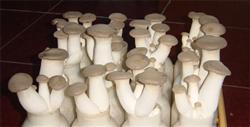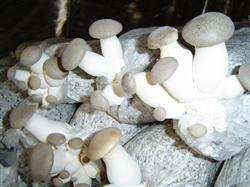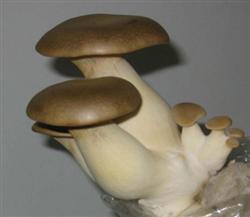How to cultivate Pleurotus eryngii

How to cultivate Pleurotus eryngii? Please introduce in detail the cultivation methods of Pleurotus eryngii can refer to the following cultivation methods: ㈠ cultivation raw materials are suitable for the growth of Pleurotus eryngii, such as miscellaneous sawdust, cotton husk, corncob, bagasse, bean straw and so on can be used as main materials. In order to prevent breaking the cultivation bag and facilitate mixing bag (bottle), sawdust must be sifted and straw must be crushed. Auxiliary materials can be added to wheat bran, rice bran, corn flour, cottonseed meal, calcium carbonate, sugar, gypsum powder and so on. According to the experimental data at home and abroad, using rice straw as the main material, even with the addition of cotton husk, the mushroom emergence is relatively late, the mushroom emergence rate is low, and the yield is also low. There are abundant rice straw resources in southern China. Growers can carry out cultivation experiments with rice straw as the main material to explore the reasons. ㈡ cultivation season is cultivated under natural conditions, according to the suitable growth temperature of Pleurotus eryngii, it is generally suitable for cultivation in autumn, winter and spring, but in areas with high winter temperature, it is better to produce mushrooms in December-February. It is difficult to form primordia because the temperature is too high or too low, which is not conducive to the growth and development of fruiting bodies. Therefore, the appropriate mushroom emergence period should be arranged according to the suitable temperature in both the south and the north, and the cultivation bag should be made 50 days in advance when the air temperature drops to 18 ℃. If there are conditions, cold storage can also be used for off-season cultivation in summer, and the economic benefit is higher. The cultivation of Pleurotus eryngii in ㈢ has bottle cultivation, box cultivation and bag cultivation because of the different culture containers used. Among them, the most convenient and practical one is bag cultivation, which is specially introduced in advance. 1. The purpose of this method is to use the original bed of the cold storage to reduce the investment cost. The bed frame of the cold storage is generally 6 layers, the distance between the bed frame layer is 60 cm, and the bed width is 120 cm. The practical cultivation area is calculated as follows: mushroom room area x60% x bed rack number, such as mushroom room plane area 100m2x60%x6 = 360m2, using a single head mushroom bag with a width of 20 cm and a length of 32 cm, with 1.2kg of wet material per bag and 80 bags per 1 m2 bed frame. The mushroom house can be cultivated in about 28000 bags, with an average of 280 bags per 1 m2 mushroom room. Three improvements must be carried out in the cold storage mushroom room: ⑴ should open additional ventilation windows near the ground and install two-way fans with shutters in order to remove heavy CO2 gas in time. ⑵ suitable light is a necessary condition for Pleurotus eryngii to produce mushrooms normally, so fluorescent lamps should be added to each mushroom bed, and the intensity can reach 300-500Lx in the darkest part. High-pressure water pipes should be installed in the ⑶ mushroom room to install the spraying device and improve the air humidity. In addition, it is best to have drainage floor drain in order to remove sewage and clean the environment. two。 The vertical frame horizontal bag type is suitable for the greenhouse, and the advantages of using vertical frame horizontal bag are as follows: ⑴ is easy to set up lighting, angle steel material can be used, no shelf plate is needed, and the investment is saved. ⑵ is easy to pass, and the operation and management of bag laying, bag opening and mushroom picking are intuitive and convenient. ⑶ can store 178bags per 1 m2 mushroom house on average. The data are as follows: the mushroom house is 15m long, 9m wide and has a flat area of 135m2. Eight rows of angle steel frames with a height of 2.5m x long 12m=30 m2 are set, and the total plane of the bag is about 240m2. The frame width is 0.2 m, horizontal steel sorghum is provided for every 0.7 m height, one vertical steel is provided for every 1 m width, and the frame spacing is 0.9 m. A double-headed mushroom bag is used, 17cm wide and 34cm long, 1.2kg of wet material per bag and 100bags per l / m2 bedstead. The mushroom house can be cultivated in about 24000 bags, with an average of 178bags per 1m2 mushroom room. ㈢ original seed preparation medium formula: sawdust 73%, wheat bran 25%, sugar 1%, calcium carbonate 1%. Wheat, barley, corn, sorghum and other grains can also be used as culture media. According to the conventional method of ingredient, treatment, bottling (bag), sterilization, inoculation and culture, it usually takes 30-35 days for the mycelium to grow full of the bottle (bag) with the first kind of medium, and with the latter several kinds of grain medium, the mycelium grows more quickly, about 20 days. ㈣ cultivation formula can be prepared according to local conditions, and here are five recipes for selection: 1. Sawdust 36%, cottonseed shell 38%, wheat bran 24%, sugar 1%, calcium carbonate 1%. two。 Sawdust 23%, cottonseed husk 23%, wheat bran 19%, corn meal 5%, bean stalk powder 28%, calcium carbonate 1%, sugar 1%. 3. Miscellaneous sawdust 23%, cottonseed shell 38%, bean stalk powder 15%, wheat bran 17%, corn meal 5%, calcium carbonate 1%, white sugar 1%. 4. Sawdust 37%, cottonseed shell 37%, wheat bran 18%, cornmeal 5%, calcium carbonate 1%, sugar 1%, lime powder 0.5%. 5. Bagasse 70%, rice bran 20%, corn meal 7%, sugar 1%, gypsum powder 1%, lime powder 1%. The production of cultivation bag of Pleurotus eryngii made by ㈤ is similar to that of Flammulina velutipes. Polypropylene bag can be selected for cultivation in early autumn. the advantage of this bag is good transparency, the material bag is tightened after high temperature sterilization, there is no gap between the film materials, and it is not easy to produce sandwich mushrooms. The disadvantage is that it is easy to break at low temperature in winter, so it is appropriate to choose high-density and low-pressure polyethylene bags. Mix the culture material well according to the proportion of the formula, adjust the water content to about 68%, use a single-end mushroom bag, each bag contains 1.2 kg of wet material, preferably ring and cotton plug, breathable and bacteria fast. Steam sterilization under l.5kg/cm2 pressure for 2 hours, or atmospheric steam sterilization for 100 ℃ for 16 hours. Inoculated with cotton seed shell bacteria, 1 bottle bacteria can be inoculated with 30 bags. After inoculation, it was placed upright on the bed frame of the bacteria room and cultured in the absence of light, and the temperature was kept at about 25 ℃. Use double-headed mushroom bag, each bag containing 1.2 kg of wet material. Fold the mouth of the bag or tie the rope. After the waiting material is warmed up to room temperature, it is inoculated in the inoculation box (room) according to the aseptic operation rules. Inoculate cotton seed shell bacteria, 1 bag bacteria inoculated 15-20 bags. Because there is no cotton plug at the mouth of the bacterial bag, when the mycelium growth reaches more than 1 per cent of the material, it is necessary to loosen the bag mouth appropriately and increase oxygen to promote mycelium growth. ㈥ management of mushroom production is carried out immediately after the mycelium is full. The single-head mushroom bag can be placed vertically on the bed frame, and the double-head mushroom bag can be horizontally coded on the bed frame. The technical points are as follows: 1. When opening the bag when the mycelium has not yet twisted, it is difficult to form the primordium or the formation of the primordium is very slow, the mushroom is irregular, and the economic character of the mushroom body is poor; when the primordium is formed or the small mushroom bud is formed, the primordium differentiation and the development of the mushroom are normal, and the mushroom body has a good economic character; if the fruiting body has grown, deformed mushrooms will appear in the bag, and the mushrooms will atrophy and rot in serious cases. Therefore, the opening time of Pleurotus eryngii in bag cultivation should be mastered when the mycelia kink to form primordia and small mushroom buds have appeared, unlock the mouth of the bag, roll the bag film outward and fold it to higher than the material 2cm. two。 The temperature of temperature-controlled mushroom house directly affects the formation of primordium and the growth and development of fruiting body. When the temperature is below 8 ℃, the primordium is difficult to form, even the already grown mushroom body will stop growing, shrinking, yellowing and dying; when the temperature remains above 18 ℃, the differentiated fruiting body will suddenly grow rapidly and the quality will decline. When the temperature is above 20 ℃, the hyphae turn to vegetative growth, the effect of low temperature stimulation disappears, the primordium stops developing, the nutrients in the mushroom buds turn back and wilt, and the formed young mushrooms will wither and die. Therefore, the temperature of the mushroom room should be controlled at 13-15 ℃ during the mushroom emergence period, so that the mushroom can be harvested in about 15 days. 3. The air humidity of the moisturizing mushroom room should be kept at 85% Mel 95%. If the humidity is too low, the fruiting body will shrink, and the primordium will not be able to differentiate. In order to improve the air humidity, it is best to spray water upward with a sprayer head. Do not spray water on the mushroom body, otherwise the fruiting body will turn yellow and affect the quality. In serious cases, it will cause decay. 4. Sufficient oxygen is needed in the present base stage of ventilation, and the concentration of CO2 should be reduced to about 0.5%. Otherwise, the primordium does not differentiate and expands into a ball. During the period of mushroom growth and development, fresh air is also needed, and the concentration of CO2 should not be higher than 0.4%. If the ventilation is poor during the mushroom emergence period, abnormal mushrooms will appear due to the high concentration of CO2, and the fruit body will rot if it encounters high temperature and high humidity. Therefore, good ventilation conditions must be maintained in the mushroom room during the mushroom emergence period, especially when a large number of mushroom buds occur, straighten the bag film in time to avoid deformity of mushroom buds due to hypoxia. 5. The growth and development of primordia and fruiting bodies need a certain amount of scattered light, and the suitable light intensity is 300-500Lx. Note that each layer or row of bedstead should have appropriate lighting, not dead corners. The harvest and yield of ㈦ can be harvested about 15 days after budding. The suitable harvest time is when the mushroom body is bowling ball, the mushroom cover has not been unfolded and the spores have not been ejected. The harvest standard should be determined according to the needs of the market: the foreign trade export mushroom requires the mushroom cap diameter 4-6cm, the handle length 6-8cm; the domestic trade market is not very strict on the mushroom body. After picking the first tide mushroom, the second tide mushroom can be picked after about 2 weeks of culture. the second tide mushroom has smaller blossoming shape, short stalk and low yield. Under normal circumstances, the yield of Pleurotus ostreatus is about 100-150 grams per bag, and the general total biological efficiency is 40-60%. If the material bag is watered or covered with soil in the later stage, the mushroom yield can reach 100% of the dry material weight. ㈧ soil mulching cultivation according to Wang Shufang et al, the bioconversion rate of unbagged bed mulching before mushroom production was the highest (99.34%), followed by unbagged bed mulching after the emergence of Pleurotus ostreatus (78.10%), and the bioconversion rate without bagging and soil mulching was the lowest (59.76%), indicating that the yield of Pleurotus eryngii cultivation with soil mulching was higher than that without soil mulching, and the yield of soil mulching earlier was higher than that of soil mulching later. Bed soil mulching can significantly improve the bioconversion rate, the reasons are as follows: 1. Bed mulching has the function of retaining water and fertilizer, and water can permeate through the soil to achieve the humidity needed by the fruiting body. two。 Soil mulching is beneficial to replenishing water and topdressing fertilizer, and the nutrition of nutritious soil is constantly added to the cultivation material through the infiltration of water to increase the stamina of mushroom production. 3. The soil itself contains a lot of organic matter and mineral elements, which can also supplement nutrients to the material through the leaching of the soil. 4. Soil also has a protective effect, avoiding the exposure of cultivated materials and reducing the occurrence of diseases and insect pests, which is also an important factor to improve the conversion rate. ㈨ processing and sales of fresh mushrooms can be listed directly, or plastic boxes can be used to cover fresh film into the supermarket. The shelf life of Pleurotus eryngii is a little longer than that of ordinary mushrooms, and it will not deteriorate when kept in a 4 ℃ refrigerator for 10 days, 5-6 days at 10 ℃ and 2-3 days at 15 ℃. Pleurotus eryngii can be processed into dried products. The dried food has a good flavor, crisp taste and fresh taste after being soaked. Because the meat is thick, it is difficult to bake the whole dried product with dehydration into a qualified shape, so it is necessary to slice it before dehydration and dry it according to the technological requirements. Dry products are white to creamy and have a good appearance. Pleurotus eryngii can also be canned. After boiling, Pleurotus eryngii is not as easily rotten and broken as Pleurotus ostreatus. After slicing and canning, it still maintains crisp and tender characteristics, and the flavor is excellent. Click to get more cultivation techniques of Pleurotus eryngii
- Prev

What do we need to pay attention to in cultivating Pleurotus eryngii?
What do we need to pay attention to in cultivating Pleurotus eryngii? Pleurotus eryngii gets its name because of its unique almond flavor and fleshy flesh. It is nutritious and is a newly developed rare mushroom species in recent years. The following problems should be paid attention to during cultivation: 1. Cultivation season: Pleurotus eryngii belongs to medium and low temperature type fungi, mycelium growth temperature.
- Next

How to cultivate Pleurotus eryngii twice a year
How to cultivate Pleurotus eryngii twice a year? Please guide Pleurotus eryngii, mainly edible mushroom stalk, which is favored by the market because of its fresh and tender taste and pleasant aroma of almonds. It is understood that in recent years, the market has been in short supply, and the seasonal sales price is very high. Production and management benefits are considerable.
Related
- Fuxing push coffee new agricultural production and marketing class: lack of small-scale processing plants
- Jujube rice field leisure farm deep ploughing Yilan for five years to create a space for organic food and play
- Nongyu Farm-A trial of organic papaya for brave women with advanced technology
- Four points for attention in the prevention and control of diseases and insect pests of edible fungi
- How to add nutrient solution to Edible Fungi
- Is there any good way to control edible fungus mites?
- Open Inoculation Technology of Edible Fungi
- Is there any clever way to use fertilizer for edible fungus in winter?
- What agents are used to kill the pathogens of edible fungi in the mushroom shed?
- Rapid drying of Edible Fungi

